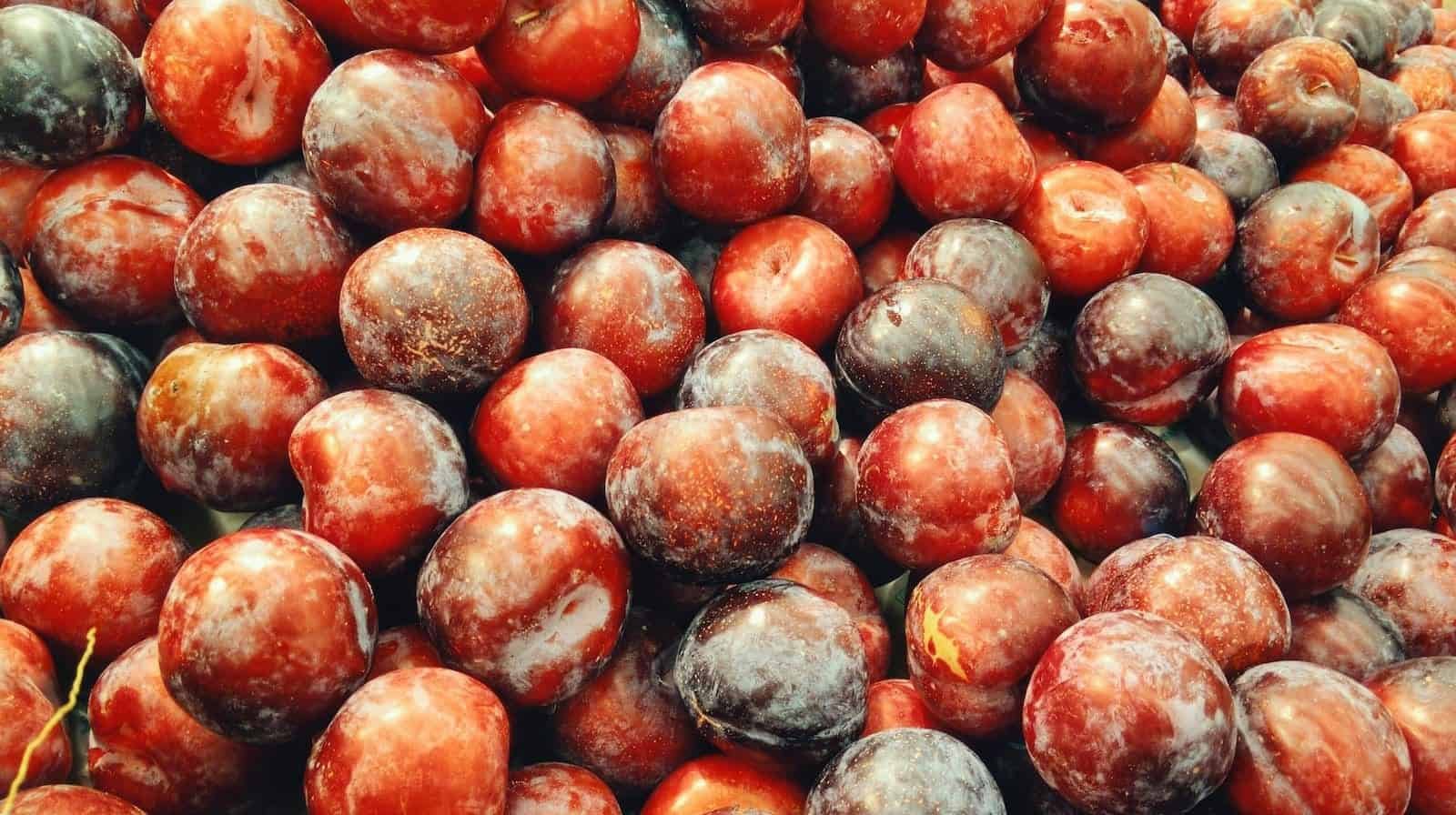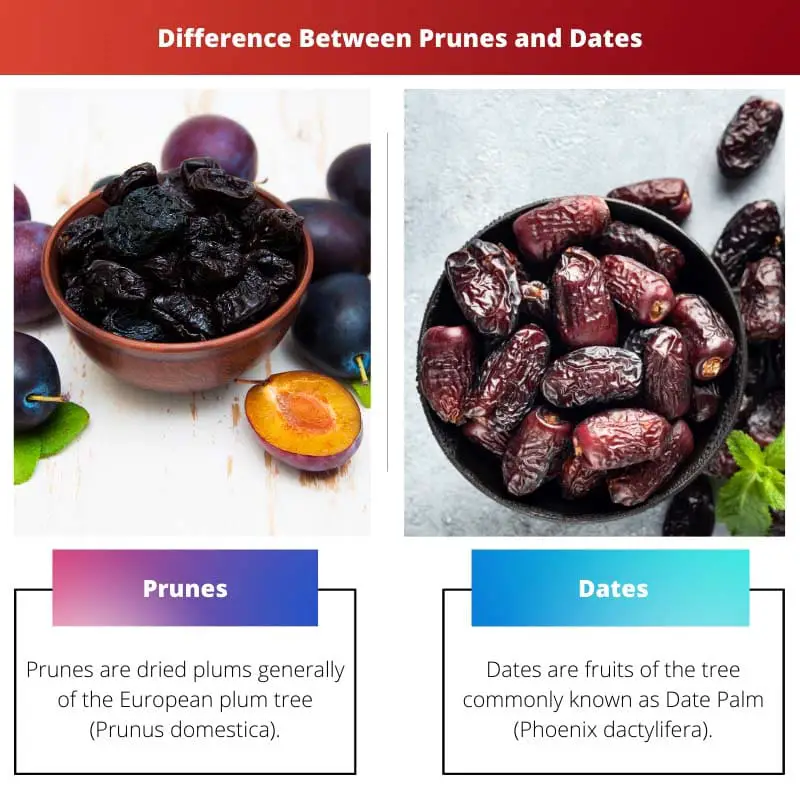Prunes, derived from dried plums, offer a rich source of fiber and sorbitol, aiding digestion and preventing constipation. Dates, high in natural sugars and essential nutrients like potassium, provide sustained energy and support bone health, making them a popular choice for snacking and natural sweetening in recipes.
Key Takeaways
- Prunes and Dates are two dried fruits popular for their sweet, rich flavors and nutritional value.
- Prunes are dried plums known for their high fiber content, while Dates are the fruit of the date palm tree and are rich in antioxidants and other nutrients.
- While both fruits are healthy and delicious, they have different flavors, and culinary uses, with Prunes used in baking and Dates, enjoyed as a snack or sweetener.
Prunes vs Dates
The difference between prunes and dates is their type. They are different fruits of different species and thus differ in appearance, taste and uses.

Prunes are a type of plum but in a dried form. They are closely related to cherries, almonds and peaches.
In biological classification, prunes belong to the genus and subgenus Prunus. Prunes are consumed all over the world as a dry fruit and also as an ingredient in different sweet and savoury dishes.
These are rich in micronutrients and vitamins. Dates are fruits of the Date Palms (Phoenix dactylifera) grown in different world regions.
They belong to the genus Phoenix. Dates are nutrient-rich, used in a wide variety of dishes, and consumed both fresh and dried.
Comparison Table
| Feature | Prunes | Dates |
|---|---|---|
| Type of Fruit | Dried plum | Dried date fruit (from the date palm) |
| Taste | Milder sweetness with a hint of acidity | Sweeter, caramel-like, or butterscotch-like |
| Texture | Chewy, slightly sticky | Soft, chewy, or slightly gooey |
| Color | Dark brown, almost black | Light brown to dark brown, depending on variety |
| Calories (per 100g) | 240 | 282 |
| Carbohydrates (per 100g) | 63.88 g (including 6.7 g fiber) | 75.1 g (including 8.7 g fiber) |
| Sugar (per 100g) | 51.81 g | 64.5 g |
| Fat (per 100g) | 0.38 g | 0.4 g |
| Protein (per 100g) | 2.18 g | 2.4 g |
| Vitamins | High in vitamin A, K, B6, and copper | High in vitamins B6 and K, and minerals like potassium, magnesium, and iron |
| Minerals | Potassium, copper | Potassium, magnesium, iron, and calcium |
| Laxative effect | Mild to moderate | Mild |
| Common uses | Baking, snacks, trail mix | Snacks, baking, sweet dishes |
What are Prunes?
Prunes, also known as dried plums, are fruits that have been dried to remove most of their moisture content. They are widely recognized for their unique sweet flavor and chewy texture. Prunes are commonly consumed as a snack or used in cooking and baking due to their versatile nature and numerous health benefits.
Origin and Cultivation
Prunes are believed to have originated from Western Asia, particularly in areas around the Caucasus Mountains. However, they have been cultivated and enjoyed for centuries in various parts of the world. The primary producers of prunes today include the United States, France, and Chile.
Nutritional Profile and Health Benefits
- Digestive Health: Prunes are well-known for their natural laxative effects, making them effective in relieving constipation and promoting regular bowel movements. This is primarily attributed to their high fiber content and sorbitol, a sugar alcohol known for its mild laxative properties.
- Bone Health: Prunes are a good source of vitamin K, which plays a crucial role in bone metabolism and helps maintain bone density. Regular consumption of prunes may contribute to improved bone health and reduce the risk of osteoporosis.
- Antioxidant Properties: Prunes contain various antioxidants, such as phenolic compounds and beta-carotene, which help neutralize harmful free radicals in the body. These antioxidants may help reduce the risk of chronic diseases, including heart disease and certain types of cancer.
- Blood Sugar Regulation: Despite their sweet taste, prunes have a low glycemic index, meaning they cause a slower and more gradual increase in blood sugar levels compared to high-sugar foods. This makes them suitable for individuals with diabetes or those aiming to manage blood sugar levels.
Culinary Uses
Prunes are incredibly versatile and can be enjoyed in various ways. They can be eaten as a standalone snack, added to breakfast cereals, salads, or incorporated into savory dishes such as stews and tagines for a hint of sweetness. Prunes are also commonly used in baking, where they add moisture and natural sweetness to cakes, muffins, and bread.

What are Dates?
Dates are the fruit of the date palm tree, known scientifically as Phoenix dactylifera. They are one of the oldest cultivated fruits and have been a staple food in Middle Eastern and North African cultures for thousands of years. Dates are prized for their sweet flavor, chewy texture, and numerous health benefits.
Origin and Cultivation
Date palms are native to the Middle East and North Africa but are now cultivated in many regions with suitable climates, including the Mediterranean, California, and parts of Asia. The cultivation of date palms dates back to ancient times, with archaeological evidence suggesting that they were domesticated as early as 4000 BCE in present-day Iraq.
Nutritional Profile and Health Benefits
- Rich in Nutrients: Dates are packed with essential nutrients such as potassium, magnesium, vitamin B6, and iron. These nutrients play vital roles in maintaining overall health, including regulating blood pressure, supporting muscle function, and preventing anemia.
- High in Fiber: Dates are an excellent source of dietary fiber, both soluble and insoluble. Fiber promotes digestive health by preventing constipation, supporting regular bowel movements, and feeding beneficial gut bacteria. It also helps control blood sugar levels and may lower the risk of heart disease.
- Antioxidant Properties: Dates contain various antioxidants, including flavonoids, carotenoids, and phenolic acids, which help neutralize harmful free radicals in the body. Antioxidants protect cells from oxidative damage, reduce inflammation, and may lower the risk of chronic diseases such as heart disease and cancer.
- Bone Health: Dates are a good source of minerals like potassium, magnesium, and manganese, which are essential for bone health. These minerals help maintain bone density, prevent osteoporosis, and support overall bone strength.
Culinary Uses
Dates are incredibly versatile and can be enjoyed in numerous ways. They are commonly eaten fresh or dried as a natural sweet treat. Dates can also be incorporated into a variety of dishes, including desserts, smoothies, salads, and savory dishes like tagines and curries. They are used as a natural sweetener in baking, replacing refined sugars in recipes for cakes, cookies, and energy bars.

Main Differences Between Prunes and Dates
- Origin:
- Prunes are derived from dried plums, whereas dates come from the fruit of the date palm tree.
- Nutritional Composition:
- Prunes are rich in fiber and sorbitol, aiding digestion and preventing constipation.
- Dates are high in natural sugars and essential nutrients like potassium, providing sustained energy and supporting bone health.
- Taste and Texture:
- Prunes have a chewy texture and a sweet-tart flavor.
- Dates are chewy with a caramel-like sweetness.
- Culinary Uses:
- Prunes are commonly used in cooking, baking, and as a natural sweetener in recipes.
- Dates are enjoyed as a snack, in desserts, smoothies, salads, and savory dishes, used as a natural sweetener in baking.
- Health Benefits:
- Prunes are known for aiding digestion, supporting bone health, and providing antioxidants.
- Dates are prized for their energy-boosting properties, bone health support, and antioxidant content.




